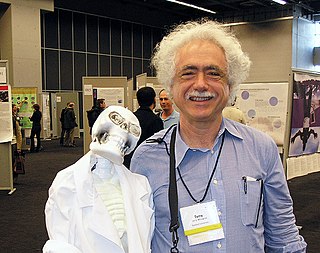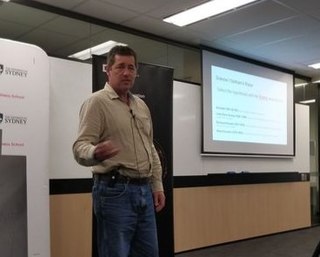Related Research Articles
Natural language understanding (NLU) or natural language interpretation (NLI) is a subset of natural language processing in artificial intelligence that deals with machine reading comprehension. NLU has been considered an AI-hard problem.
Computer science is the study of the theoretical foundations of information and computation and their implementation and application in computer systems. One well known subject classification system for computer science is the ACM Computing Classification System devised by the Association for Computing Machinery.

Terry Allen Winograd is an American computer scientist. He is a professor at Stanford University, and co-director of the Stanford Human–Computer Interaction Group. He is known within the philosophy of mind and artificial intelligence fields for his work on natural language using the SHRDLU program.

CA Technologies, Inc., formerly Computer Associates International, Inc., and CA, Inc., was an American multinational enterprise software developer and publisher that existed from 1976 to 2018. CA grew to rank as one of the largest independent software corporations in the world, and at one point was the second largest. The company created systems software that ran in IBM mainframe, distributed computing, virtual machine, and cloud computing environments.
I. P. Sharp Associates (IPSA) was a major Canadian computer time-sharing, consulting and services firm of the 1970s and 1980s. IPSA is well known for its work on the programming language APL, an early packet switching computer network named IPSANET, and a powerful mainframe computer-based email system named 666 Box, stylized as 666 BOX. It was purchased in 1987 by Reuters Group, which used them until 2005 as a data warehousing center for business data.
Cincom Systems, Inc., is a privately held multinational computer technology corporation founded in 1968 by Tom Nies, Tom Richley, and Claude Bogardus. The company’s first product, Total, was the first commercial database management system that was not bundled with manufacturer hardware and proprietary software. In June 2024, Cincom Systems Inc. was acquired by PartnerOne, a Canada-based enterprise software company. At the time of the sale, Cincom had 400 employees both in the US and internationally.
Plug compatible refers to "hardware that is designed to perform exactly like another vendor's product." The term PCM was originally applied to manufacturers who made replacements for IBM peripherals. Later this term was used to refer to IBM-compatible computers.
RAMIS is a fourth-generation programming language (4GL) capable of creating and maintaining databases consisting of named files containing both numeric and alphabetic fields and subsequently producing detailed simple or complex reports using a very simple English like language. As such it is easily mastered by non-programmers. A typical program - either to create or maintain a database or to create quite complex reports - would normally consist of a handful of lines of code which could be written or understood by non-professional programmers. "End users" as they became known. Such end users could be trained to use RAMIS in a matter of days and so large companies would often have several hundred such users scattered throughout the company.
The following outline is provided as an overview of and topical guide to artificial intelligence:
Natural-language programming (NLP) is an ontology-assisted way of programming in terms of natural-language sentences, e.g. English. A structured document with Content, sections and subsections for explanations of sentences forms a NLP document, which is actually a computer program. Natural language programming is not to be mixed up with natural language interfacing or voice control where a program is first written and then communicated with through natural language using an interface added on. In NLP the functionality of a program is organised only for the definition of the meaning of sentences. For instance, NLP can be used to represent all the knowledge of an autonomous robot. Having done so, its tasks can be scripted by its users so that the robot can execute them autonomously while keeping to prescribed rules of behaviour as determined by the robot's user. Such robots are called transparent robots as their reasoning is transparent to users and this develops trust in robots. Natural language use and natural-language user interfaces include Inform 7, a natural programming language for making interactive fiction, Shakespeare, an esoteric natural programming language in the style of the plays of William Shakespeare, and Wolfram Alpha, a computational knowledge engine, using natural-language input. Some methods for program synthesis are based on natural-language programming.
Natural-language user interface is a type of computer human interface where linguistic phenomena such as verbs, phrases and clauses act as UI controls for creating, selecting and modifying data in software applications.
Easytrieve is a report generator, sold by CA Technologies. Easytrieve Classic and Easytrieve Plus are two available versions of this programming language primarily designed to generate reports and are used by large corporations operating in mainframe, UNIX, Linux, and Microsoft Windows environments.

Michael Ralph Stonebraker is an American computer scientist specializing in database systems. Through a series of academic prototypes and commercial startups, Stonebraker's research and products are central to many relational databases. He is also the founder of many database companies, including Ingres Corporation, Illustra, Paradigm4, StreamBase Systems, Tamr, Vertica and VoltDB, and served as chief technical officer of Informix. For his contributions to database research, Stonebraker received the 2014 Turing Award, often described as "the Nobel Prize for computing."
The following outline is provided as an overview of and topical guide to natural-language processing:

John Samuel Ball is an American cognitive scientist, an expert in machine intelligence, computer architecture and the inventor of Patom Theory.
This glossary of artificial intelligence is a list of definitions of terms and concepts relevant to the study of artificial intelligence (AI), its subdisciplines, and related fields. Related glossaries include Glossary of computer science, Glossary of robotics, and Glossary of machine vision.
Mathematica Inc. was a multi-faceted American software company and consulting group founded by Princeton University professors in 1968. The company had three primary divisions: Mathematica Policy Research, which did consulting work, mostly "to develop mathematical models for marketing decision making"; Mathematica Products Group, best known for developing the RAMIS programming language; and MathTech, the company's technical and economic consulting group. The company was also a leading developer of state lottery systems.

The Department of Computer Science is a department of the Technische Universität Darmstadt. With a total of 36 professorships and about 3,700 students in 12 study courses, the Department of Computer Science is the largest department of the university. The department shapes the two research profile areas "Cybersecurity (CYSEC)" and "Internet and Digitization (InDi)" of the university.
References
- 1 2 3 4 Lucci, Stephen; Kopec, Danny (10 December 2015). Artificial Intelligence in the 21st Century. Stylus Publishing, LLC. ISBN 9781944534530 – via Google Books.
- 1 2 3 "Whatever happened to artificial intelligence?". PC World.
- ↑ Harris, Larry R. (20 June 1978). "The ROBOT System: Natural Language Processing Applied to Data Base Query". ACM '78: Proceedings of the 1978 annual conference. Association for Computing Machinery: 165–172. doi: 10.1145/800127.804087 . S2CID 1732335.
- ↑ Enterprise, I. D. G. (17 August 1987). "Computerworld". IDG Enterprise – via Google Books.
- ↑ Jorna, René J.; Heusden, Barend van; Posner, Roland (20 June 1993). Signs, Search and Communication: Semiotic Aspects of Artificial Intelligence. Walter de Gruyter. ISBN 9783110136586 – via Google Books.
- ↑ Ronald Rosenberg (June 16, 1983). "A natural language of its own". Boston Globe. p. 68.
- 1 2 Taylor, William A. (1988). What Every Engineer Should Know about Artificial Intelligence. MIT Press. ISBN 9780262200691.
- ↑ Williamson, Mickey (1987-11-23). "AI Joins the Working World". Computerworld. Vol. 21, no. 47. International Data Group. Retrieved 2019-06-22.
- ↑ Edelman, Lawrence (1990-06-27). "AICorp of Waltham Goes Public". The Boston Globe. p. 45.
- ↑ "Larry R. Harris: Executive Profile & Biography". Bloomberg. Retrieved 2019-06-22.